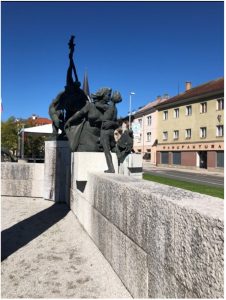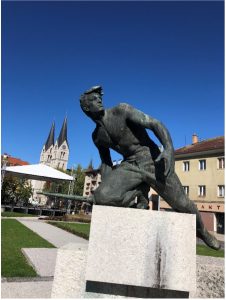Osrednji kip v središču Kočevja
Ob mestni ploščadi v Kočevju se nahaja Spomenik svobode, ki je sestavljen iz 4 skulptur, podstavka in obeliska ter je delo več avtorjev. Na belih kamnitih podstavkih so bronasti kipi partizanskih borcev, ki simbolizirajo idejo borbe, osvoboditve in obnove. Gre za ogromno skulpturo, saj je zunanji obseg spomenika 35 metrov, v širino meri 7 metrov, v dolžino pa 11.

Slika 1: Spomenik svobode – celoten kip (FOTO: Nuša Veselič)
Skulptura dveh moških, ki postavljata mlaj, se imenuje Mlaj in je osrednja skulptura spomenika. Izdelal jo je Božidar Pengov. Okoli osredje so postavljene ostale 3 skulpture: Mati in kurirček, delo Lojzeta Lavriča, predstavlja mlado žensko, ki objema mladega kurirja, klečečega Strelca s puško je oblikoval Marjan Keršič, Bombašico, ki je prikazana v položaju tik pred metom ročne bombe, pa Stane Keržič. Načrt za objekt sta zasnovala akademski slikar Zoran Didek in kipar Božo Pengov.
Med Strelcem s puško in Bombašico ter na sprednji strani podstavka osrednje skulpture je slovenski grb iz obdobja 1945–1991. Na ostalih dveh prostih straneh podstavka osrednje skulpture sta napisa, ki imata poseben zgodovinski pomen za Slovence. Med Materjo s kurirčkom in Bombašico se glasi napis Ivana Cankarja: »Narod si bo sodbo pisal sam, ne frak mu je ne bo in ne talar.«, ki ga najdemo tudi v Šeškovem domu. Še en napis se nahaja na drugi strani spomenika.
Zaradi zgodovinskega, družbenega in političnega pomena zasedanja Zbora odposlancev slovenskega naroda je bil ob njegovi 10-letnici odkrit spomenik 3. oktobra 1953, na mestu, kjer je stal nekdanji grad.

Slika 2: Mati in Kurirček (FOTO: Nuša Veselič)

Slika 3: Strelec (FOTO: Nuša Veselič)
Kiparski kompleks je nastal kot odziv na hude zgodovinske okoliščine med 2. svetovno vojno, v kateri je bilo Kočevje kar dvaindvajsetkrat bombardirano in je spadalo med najbolj prizadeta slovenska mesta.
Kot zanimivost naj omenim povezavo med Spomenikom svobode v Kočevju in spomenikom Razdrto mesto, ki ga je izdelal Ossip Zadkine in stoji v Rotterdamu na Nizozemskem. Oba primerja Stane Bernik v svojem delu Kočevje (urbanistično-arhitekturni oris). Poleg tega, da sta spomenika nastajala skoraj istočasno, sta nastala kot odziv na 2. svetovno vojno. Razdrto mesto predstavlja človeka, ki mu je bilo iztrgano srce. Postavljen je bil zato, da se dogodki, ki so se zgodili, ne bodo pozabljeni. Spomenik svobode je bolj realističen in opisen, medtem ko je Razdrto mesto izdelano v kubistično-ekspresionističnem slogu, saj je kip sestavljen iz razklanih oblik, ki se spajajo v celoto.
Čeprav sem v mestu skoraj vsak dan, nanj nisem bila tako pozorna. Poznala sem kip in bil mi je všeč, vendar o njem nisem nikoli razmišljala v povezavi z zgodovino mesta Kočevje. Kip se lepo zliva z okolico in ne izstopa. Obrazi upodobljenih skulptur so brezizrazni. Menim, da je spomenik nekaj posebnega predvsem zaradi zgodbe o svojem nastanku. Zanimivo je, da je spomenik prinašal toliko upanja in pozitivnega mišljenja, kljub temu da je bil postavljen na mestu nekdanjega gradu.
Nuša Veselič, 3. b (šol. l. 2021/2022)
VIRI IN LITERATURA:
- BERNIK, S. (1969). Kočevje. Urbanistično-arhitekturni oris, topografsko gradivo. Ljubljana: Zavod za spomeniško varstvo Ljubljana.
- RESMAN B., SERAŽIN H., (2010). Upravna enota Kočevje, občine Kočevje, Kostel in Osilnica. Ljubljana: Zavod za spomeniško varstvo Ljubljana.
- ŠMAJDEK, P. (2011). Kočevje – Spomenik NOB. Spletna stran Simboli polpretekle zgodovine. Dostopno 21. 11. 2021 na: https://spomeniki.blogspot.com/2011/11/kocevje.html
- GOLOB, N. (2006). Umetnostna zgodovina. Učbenik. Ljubljana: DZS.
THE MONUMENT OF FREEDOM
The Main statue in the center of Kočevje
The Monument of Freedom is located in the main city square in Kočevje. It is composed of 4 sculptures, a base and an obelisk. The Monument is the work of multiple authors. On the white stone bases there are bronze statues of Partisan soldiers who symbolize the idea of battle, liberation and renewal. It is an enormous sculpture, the outer circumference of which measures 35 meters, its width measures 7 meters and its length 11 meters.
The sculpture of two men setting up a maypole is called Mlaj (Maypole) and is the central sculpture of the monument. It was cerated by Božidar Pengov. Around the central sculpture 3 remaining sculptures are arranged: Mati in Kurirček (The mother and the Young Courier), the work of Lojze Lavrič and it represents a young woman who is hugging a young courier. The kneeling Strelec s puško (The Shooter with a Shotgun) was created by Marjan Keržič, and Bombašica (The Woman Throwing Bombs) in a position before she throws a hand-bomb is the work of Stane Keržič. The plan for the structure was designed by the academic painter Zoran Didek and the sculptur Božo Pengov.
Between the sculptures of The Shooter with a Shotgun and The Woman Throwing Bombs, on the front side of central sculpture`s base there is the Slovenian coat-of-arms from the period between 1945 and 1991. On the other two sides of the base there are insriptions that have a historical meaning for Slovenians. Between the sculptures of The Mother with the Young Courier and The Woman Throwing Bombs there is Ivan Cankar`s inscription: »Narod si bo sodbo pisal sam, ne frak mu je ne bo in ne talar.«(The nation will write its own judgement, nither the tailcoat (temporal power) nor the vestment (church) can do so.). The inscription is also found in the hall Šeškov dom. Another inscription is located on the other side of the monument.
Because of historical, social and political meaning of the Assembly of the Slovene Nation Delegates, the monument was unveiled at the 10th anniversary of the event, on October 3rd 1953, on the spot where the former castle once stood.
The sculpture complex was made as a responese to bad historical circumstances in World War II. Kočevje was bombed twenty-two times and it was one of the most demolished Slovenian cities.
As an interesting fact let me add the connecton between The Monument of Freedom in Kočevje and the monument Razdrto mesto (The Demoblished City), which was made by Ossip Zadkine and is located in Rotterdam in the Netherlands. Stane Bernik compared both monuments in his work Kočevje (Urban-arhitectual Outline). Besides the fact that both monuments were created at almost the same time, they were both made as a response to World War II. The Demoblished City represents a human being whose heart was torn out. It was created so that the events that happened could never be forgotten. The Monument of Freedom is more realistic and descriptive, while The Demoblished City was made in cubist-exspressionist style. The Statue is composed of torn shapes that merge into a whole.
Even though I visit the city almost every day , I have never paid much atenttion. I knew that the monument existed and I liked it, but I never connected it with the history of Kočevje. The statue blends in nicely and does not stand out. The faces of the sculptures are expressionless. I think that the monument is special, mainly because of the story of its origin. It is interesting that the monument brought so much hope and positivity, despite the fact that it was created at the site of the former castle.
Nuša Veselič, 3. b (šol. l. 2021/2022)
VIRI IN LITERATURA:
- BERNIK, S. (1969). Kočevje. Urbanistično-arhitekturni oris, topografsko gradivo. Ljubljana: Zavod za spomeniško varstvo Ljubljana.
- RESMAN B., SERAŽIN H., (2010). Upravna enota Kočevje, Občine Kočevje, Kostel in Osilnica. Ljubljana: Zavod za spomeniško varstvo Ljubljana.
- ŠMAJDEK, P. (2011). Kočevje – Spomenik NOB. Spletna stran Simboli polpretekle zgodovine. Cited: 21 Nov. 2021. Accessible at: https://spomeniki.blogspot.com/2011/11/kocevje.html
- GOLOB, N. (2006). Umetnostna zgodovina. Učbenik. Ljubljana: DZS.